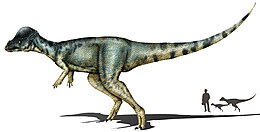| Alaskacephale Temporal range: Latest Campanian,
| |
|---|---|

| |
| Scientific classification | |
| Domain: | Eukaryota |
| Kingdom: | Animalia |
| Phylum: | Chordata |
| Clade: | Dinosauria |
| Clade: | †Ornithischia |
| Clade: | †Neornithischia |
| Clade: | †Pachycephalosauria |
| Family: | †Pachycephalosauridae |
| Genus: | †Alaskacephale Sullivan, 2006 |
| Species: | †A. gangloffi
|
| Binomial name | |
| †Alaskacephale gangloffi Sullivan, 2006
| |
Alaskacephale is an extinct genus of pachycephalosaurid, a group of dome-headed, herbivorous ornithischian dinosaurs, that lived during the Campanian stage of the Late Cretaceous period in what is now northern Alaska. The genus is one of the few known Arctic dinosaurs and was found in the Prince Creek Formation, which preserves a menagerie of fossils. The only known specimen, a squamosal bone, was found in 1999 and later described in 2005. However, Alaskacephale was not formally named until the next year.
Alaskacephale, due to the lack of fossil remains, is poorly known. Despite this, the presence of bony protuberances from the skull prove that it was a pachycephalosaur. Later phylogenetic analyses suggest it was a close relative of Pachycephalosaurus. However, Alaskacephale is distinguished from other genera by the two rows of nodules found along the squamosal.
The Prince Creek Formation bears a variety of fossils, many of them similar to other previously known Laramidian taxa. Alaskacephale coexisted with dinosaurs like the ceratopsian Pachyrhinosaurus, ornithopod Edmontosaurus, and tyrannosaurid Nanuqsaurus in addition to mammals like Unnuakomys.